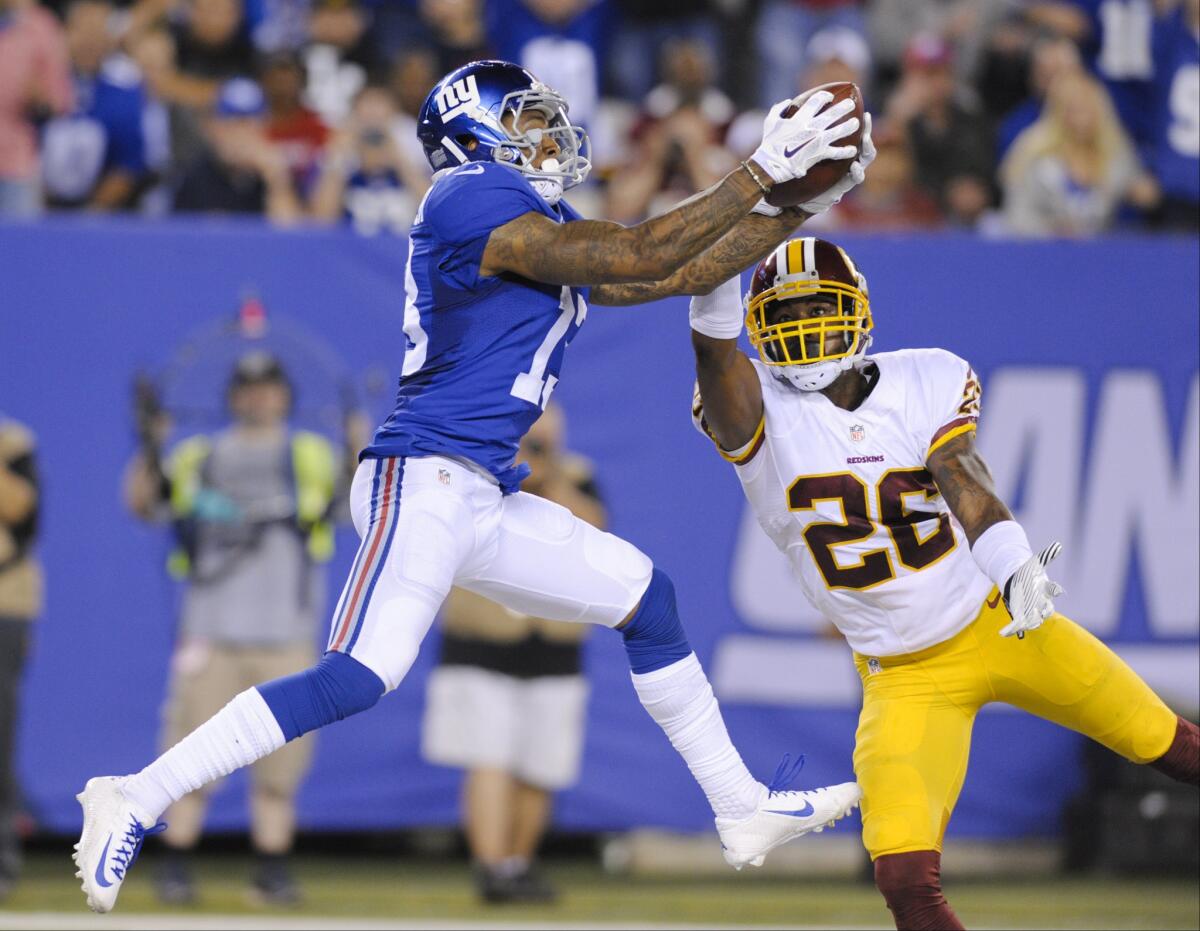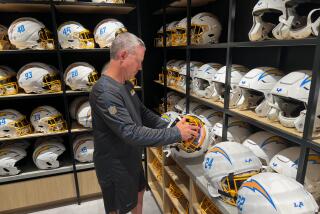NFL may address a sticky situation involving players’ gloves during league meetings this week

New York Giants receiver Odell Beckham catches a pass for a touchdown in front of Redskins cornerback Bashaud Breeland (26) during the second half a game on Sept. 24.
- Share via
FROM BOCA RATON, Fla. — The NFL seems to have a hand in everything.
Soon, the league could have its hand in gloves.
Among the many topics the competition committee will discuss this week when it convenes at the annual league meetings is how to regulate the gloves worn by virtually every player, but in particular those worn by receivers, who make once-impossible catches now look routine.
See the most-read stories in Sports this hour>>
“There are no standards right now,” said Troy Vincent, NFL executive vice president of football operations. “We have been working with our partners — Under Armour, Nike — to see how we could adjust and have some minimum standards. The challenge is the tackiness, and the gloves are now so tacky that it’s taking away from the true skill level.”
Hall of Fame coach John Madden is only half joking when he says the gloves are so adhesive these days, they could almost catch a ball without a hand in them.
Vincent said there won’t be any changes for the 2016 season, “but as we look at the 2017 campaign, we hope to have better answers and better standards as it pertains to gloves.”
These will be the first meetings in two decades in which the future of the NFL in Los Angeles is not a prominent agenda item. The situation isn’t entirely resolved in the nation’s second-largest market — there remains the question of whether the Chargers might leave San Diego after the 2016 season, or whether they’ll hand that one-year L.A. option to the Raiders — but now that the Rams have returned, the temperature is dialed down on the intrigue for the moment.
There are a host of other potential tweaks to the game in the pipeline, however, and that largely will be the focus when owners, general managers and coaches convene at the Boca Raton Resort & Club for the meetings, which take place Sunday through Wednesday.
The competition committee is studying several proposed rules changes, and the procedure calls for those to be passed along to the owners for a vote.
Among the possible changes being discussed is a two-strikes-you’re-out system in which players will be subject to ejection for receiving certain unsportsmanlike conduct penalties twice during the course of a game. There are three categories for these penalties, which do not encompass personal fouls:
•Throwing a punch or forearm, or kicking an opponent even if no contact is made.
•Using abusive, threatening or insulting language or gestures toward an opponent, teammates, officials or representatives of the league.
•Baiting or taunting acts or words that engender ill will between teams.
There were 75 unsportsmanlike-conduct calls last season, a significant increase from the average of about 50 per season the previous five years.
Rich McKay, Atlanta Falcons president and chairman of the competition committee, said that in flagrant-foul situations, the referees would still be entitled to eject a player.
“He doesn’t need to wait for that second foul,” McKay said, “and we will definitely make that a point to the officials.”
Although he was unable to identify the specific instances, McKay said there were two times last season when players would have qualified for the proposed two-strikes-you’re-out rule. He could not say whether one of those would have been the widely publicized cheap shots by New York Giants receiver Odell Beckham Jr. against Carolina cornerback Josh Norman.
Most of the proposed rules changes have to do with improving player safety. There’s a proposal to end all chop blocks — a block at thigh level or lower of a defensive player who already is being blocked by another player — expanding the definition of a “horse-collar” tackle to prohibit a defender from pulling a player down by the nameplate on his uniform, and further encouraging touchbacks by moving the ensuing line of scrimmage from the 20 to the 25.
McKay dismissed the theory that teams won’t be able to run the ball effectively if the league fully eliminates the chop block.
“I think college eliminated the chop block in 2008, and since 2008, it’s 2015, their rushing yards are up 15% a year,” he said.
“I think you’re going to hear those quotes — they come whenever a change is proposed — whether they’re from ex-players or coaches, whoever they may be. We understand them. We think we have the best coaches in the world that tend to adjust very quickly to rules and tend to find ways to get things accomplished. So we don’t see this as something that’s going to drastically affect the rushing game.”
Among the other proposed rules changes:
• Permanently moving the line of scrimmage on point-after kicks to the 15. That worked well last season, turning a gimme into a watchable play, but that was only a one-year trial.
• Removing the middleman in the coach-to-player communications system. The rule currently stipulates that players wearing helmet radios — a quarterback and a designated defensive player — can get those communications only from the sideline. The proposed rule would allow that information to come from a coach in the booth.
• Allowing coaches and players on the sideline to watch almost-real-time game video on their Surface tablets in order to make adjustments. Currently, they can view only stills.
• Increasing the number of coaches’ challenges and expanding the scope of what can be reviewed, to include personal fouls.
Follow Sam Farmer on Twitter @LATimesfarmer
More to Read
Go beyond the scoreboard
Get the latest on L.A.'s teams in the daily Sports Report newsletter.
You may occasionally receive promotional content from the Los Angeles Times.











